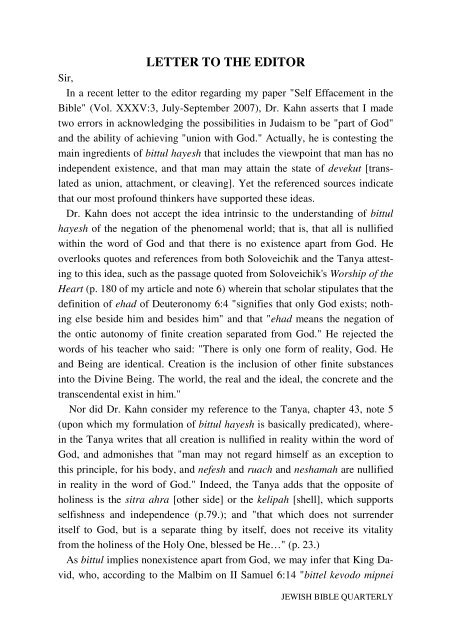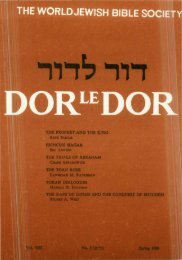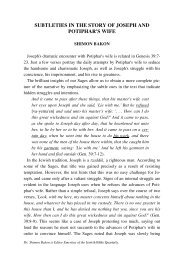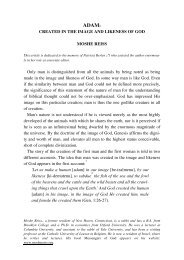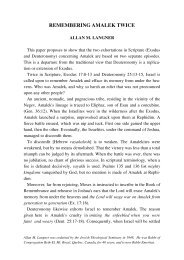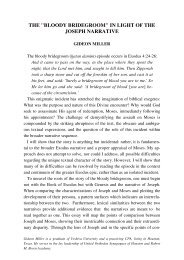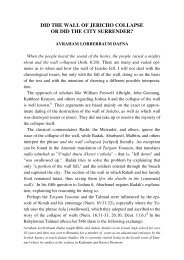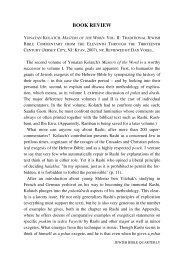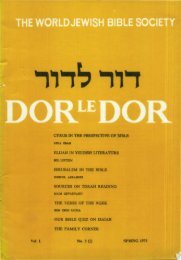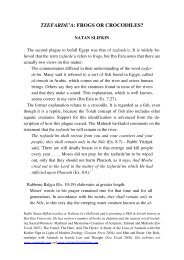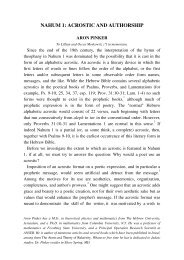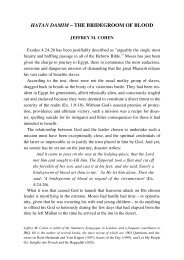LETTER TO THE EDITOR - Jewish Bible Quarterly
LETTER TO THE EDITOR - Jewish Bible Quarterly
LETTER TO THE EDITOR - Jewish Bible Quarterly
Create successful ePaper yourself
Turn your PDF publications into a flip-book with our unique Google optimized e-Paper software.
<strong>LETTER</strong> <strong>TO</strong> <strong>THE</strong> EDI<strong>TO</strong>R<br />
Sir,<br />
In a recent letter to the editor regarding my paper "Self Effacement in the<br />
<strong>Bible</strong>" (Vol. XXXV:3, July-September 2007), Dr. Kahn asserts that I made<br />
two errors in acknowledging the possibilities in Judaism to be "part of God"<br />
and the ability of achieving "union with God." Actually, he is contesting the<br />
main ingredients of bittul hayesh that includes the viewpoint that man has no<br />
independent existence, and that man may attain the state of devekut [translated<br />
as union, attachment, or cleaving]. Yet the referenced sources indicate<br />
that our most profound thinkers have supported these ideas.<br />
Dr. Kahn does not accept the idea intrinsic to the understanding of bittul<br />
hayesh of the negation of the phenomenal world; that is, that all is nullified<br />
within the word of God and that there is no existence apart from God. He<br />
overlooks quotes and references from both Soloveichik and the Tanya attesting<br />
to this idea, such as the passage quoted from Soloveichik's Worship of the<br />
Heart (p. 180 of my article and note 6) wherein that scholar stipulates that the<br />
definition of ehad of Deuteronomy 6:4 "signifies that only God exists; nothing<br />
else beside him and besides him" and that "ehad means the negation of<br />
the ontic autonomy of finite creation separated from God." He rejected the<br />
words of his teacher who said: "There is only one form of reality, God. He<br />
and Being are identical. Creation is the inclusion of other finite substances<br />
into the Divine Being. The world, the real and the ideal, the concrete and the<br />
transcendental exist in him."<br />
Nor did Dr. Kahn consider my reference to the Tanya, chapter 43, note 5<br />
(upon which my formulation of bittul hayesh is basically predicated), wherein<br />
the Tanya writes that all creation is nullified in reality within the word of<br />
God, and admonishes that "man may not regard himself as an exception to<br />
this principle, for his body, and nefesh and ruach and neshamah are nullified<br />
in reality in the word of God." Indeed, the Tanya adds that the opposite of<br />
holiness is the sitra ahra [other side] or the kelipah [shell], which supports<br />
selfishness and independence (p.79.); and "that which does not surrender<br />
itself to God, but is a separate thing by itself, does not receive its vitality<br />
from the holiness of the Holy One, blessed be He…" (p. 23.)<br />
As bittul implies nonexistence apart from God, we may infer that King David,<br />
who, according to the Malbim on II Samuel 6:14 "bittel kevodo mipnei<br />
JEWISH BIBLE QUARTERLY
<strong>LETTER</strong> <strong>TO</strong> <strong>THE</strong> EDI<strong>TO</strong>R<br />
kvod hashem [effaced his honor in favor of the honor of the Lord], viewed<br />
himself as part of God; and that Michal, concerned for her own honor, ipso<br />
facto separated herself and viewed herself as standing apart from the Lord.<br />
Is there really a barrier between heaven and earth? There are opinions to the<br />
contrary. Did not King David declare in Psalms 149:8, "Im esak shamayim<br />
sham atah v’atzia sheol hinekha [If I ascend up to heaven Thou art there; if I<br />
make my bed in sheol, behold Thou art there]." Does not Hasidism teach,<br />
"Leit atar panui mineh [There is no place devoid of Him]"? There is also the<br />
faith system taught by the Ba'al Shem Tov that calls for the belief in God's<br />
immanence and transcendence, and the Ba'al Shem Tov's parable of the mehizot<br />
found in Ben PoratYosef (Lvov, 1866, p. 55). Furthermore, the Tanya<br />
emphasized that "everything one sees with one's eyes. . . constitutes the outer<br />
garments of the King" (Tanya, ch. 42, p. 225). Also, if one wants to "gladden<br />
his heart"” one should seek "to understand His blessed true Unity: how He<br />
permeates all worlds, both upper and lower" (p. 149).<br />
Soloveichik was the spiritual heir of Rabbi Hayyim Volozhin, whose Nefesh<br />
Hahayyim introduces one to the world of the Zohar and to the teachings<br />
of the Ari that the worlds are linked, and there is a connection to the supernal<br />
realm (reprint ed., Ohio 1997, Gate 1, esp. pages 28-29). Here one can read<br />
the famous teaching of the Zohar that "every world, both upper and lower,<br />
from the start of the most secret highest point until the last of all the levels,<br />
one is a garment for the other, this within that and that within this" (Zohar on<br />
Genesis 20a, quoted on p. 29). Or, that "the worlds are so ordered and linked,<br />
that the lower is dependant on the upper, and so on until the Almighty,<br />
blessed Be He, the soul of all." A teaching of the Zohar is that "the soul of<br />
man, planted above, passes myriads of worlds until it descends into man’s<br />
body. But the most important part of the soul is attached and planted above,<br />
as if to say, part of God, and it descends as a rope until it enters the body of<br />
man." (p. 32).<br />
Although the aggada in T.B. Succah 5a pointing to a barrier between heaven<br />
and earth seems to be consistent with the notion that devekut should be<br />
interpreted as a theoretical construct, there are interpretations that claim the<br />
possibility of a union. Indeed, explanations range from supporting or marrying<br />
one's daughters to Torah scholars to the lofty height of becoming a ma’on<br />
Vol. 36, No. 2, 2008<br />
131
132<br />
<strong>LETTER</strong> <strong>TO</strong> <strong>THE</strong> EDI<strong>TO</strong>R<br />
[residence] or merkavah lashekhinah [chariot for the Shekhinah] both in<br />
body and soul.<br />
While Rashi on Deuteronomy 11:22, quoting Sifre 48,49 deems it impossible<br />
to attach oneself to God, and while the Sforno suggests that u’ledavkah<br />
bo refers to the consecration of our deeds towards the fulfillment of the will<br />
of God, many other exegetes present a more esoteric and mystical approach,<br />
suggesting an actual union with God. Ibn Ezra, who generally tends towards<br />
rationalistic exegesis, writes: “Basof. V’hu sod gadol [At the end. And this is<br />
a great secret]." The Ramban tries to unravel this cryptic interpretation, and<br />
concludes that Ibn Ezra is actually referring to the possibility that "the men of<br />
excellence, even in their lifetime, their souls shall be bound in the bundle of<br />
life (I Sam. 25:29) since their very being becomes a maon [residence] for the<br />
Divine Glory." He claims that he too arrived at a similar interpretation in<br />
Leviticus 18:5, that some people who cleave to the Glorious Name will live<br />
forever in body and soul.<br />
Rabbi Hayyim of Volozhin states that when man fulfills all the commandments<br />
he attains the state of devekut – a state wherein he is actually attached<br />
to God: "This is the meaning of devekut: Through the holiness that he receives<br />
from his deeds, he is attached to God, even in life: But you that did<br />
cleave to the Lord are alive all of you today (Deut. 4: 4)." His limbs "become<br />
holy from the supernal holiness," and "the glory of God always hovers over<br />
him," and "he corrects upper words and order, and he becomes with all his<br />
powers and limbs a chariot for them" (Nesfesh Hahayyim, pp. 40-41).<br />
The Tanya formulated the same idea, claiming even the possibility of a<br />
"perfect union" with God: ". . . in order to draw the light and effulgence of<br />
the Shekhinah also over his body and animal soul . . . he needs to fulfill the<br />
practical commandments which are performed by the body itself. For the<br />
very energy of the body itself which is engaged in this action is absorbed in<br />
the Divine light and His will and is united with Him in perfect union . . . .<br />
Thereby also the energy of the vital spirit in the physical body . . .is actually<br />
absorbed into holiness like the divine soul itself . . . (Ch. 35, p.161). The Or<br />
Hahayyim (Rabbi Hayyim Ben Moses Attar, 1696-1743) on Deuteronomy<br />
4:4 also agrees that the Divine name rests on the limb that performs a commandment.<br />
Since the 613 commandments correlate with the sum of our body<br />
parts, we may become devekim, attached or united to God.<br />
JEWISH BIBLE QUARTERLY
<strong>LETTER</strong> <strong>TO</strong> <strong>THE</strong> EDI<strong>TO</strong>R<br />
If Soloveichik did indeed rebuke his student, perhaps he did not want these<br />
teachings to be shared by the intellectually immature. It is dangerous to enter<br />
the pardes. But the views with which Dr. Kahn takes issue are intrinsic to<br />
<strong>Jewish</strong> thought, albeit they may not be known or shared by many. I hope this<br />
response has amplified Dr. Kahn’s perspectives on <strong>Jewish</strong> thought.<br />
Gloria Wiederkehr-Pollack<br />
New York, NY<br />
<br />
WHAT ONE CAN DO WITH A BA IN LIBERAL STUDIES<br />
Students who have taken 92 college credits through our NY State<br />
Board of Regents approved proficiency exams in Hebrew and Judaic<br />
Studies have used their BA from www.charteroak.edu and have gone<br />
on toward graduate and professional degrees (law school, MBA's,<br />
medical school, education, psychology, computer science).<br />
Do second BA's at hundreds of US colleges (30 credits in a new major;<br />
45 credits in accounting or engineering); go on toward graduate<br />
work at the University of Maryland; do a 2 year second BA at Columbia<br />
University in NYC with the second year being 1st year graduate or<br />
medical school or law school courses at Columbia; enter a master of<br />
science in engineering program at Boston University for humanities<br />
graduates in: biomedical, computer, electrical, manufacturing, or mechanical<br />
engineering; do a 12-15 month post-baccalaureate program<br />
to get into medical school; do a 12 month international MBA at Bar<br />
Ilan University in Israel; a 6 month post-baccalaureate teacher certification<br />
program for the public school system; follow this teacher's certification<br />
with a 30 credit master's degree in special education for state<br />
licensure; do a one year post-baccalaureate in speech therapy that allows<br />
humanities graduates to enter a master's degree program in<br />
speech pathology; enter a 2.5 year Doctor of Physical Therapy program;<br />
enter a special MSW program at Wurzweiler (2 summers plus 2<br />
semesters); go to a master's degree program in education (elementary<br />
<strong>Jewish</strong> education) at a prestigious New England university with free<br />
tuition, a $10,000 stipend and getting state licensure to teach in the<br />
public school system. INTERESTED?<br />
Email us at info@jewishbible.org Details: www.jewishbible.org<br />
Vol. 36, No. 2, 2008<br />
133


